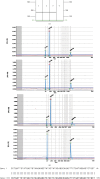Molecular Detection and Quantification of Ovine Papillomavirus DNA in Equine Sarcoid
- PMID: 40303025
- PMCID: PMC12016688
- DOI: 10.1155/2024/6453158
Molecular Detection and Quantification of Ovine Papillomavirus DNA in Equine Sarcoid
Abstract
Equine sarcoids are caused by infection with bovine papillomavirus (BPV) types 1, 2, and possibly 13. However, a number of sarcoids lack BPV DNA, and new potential etiological agents for sarcoid diseases need to be considered. High-performance digital droplet polymerase chain reaction (ddPCR) was used for the quantitative detection of ovine papillomavirus (OaPV) types 1-4 DNA from 63 sarcoid DNA samples collected in Austria. All samples were comparatively evaluated for OaPV DNA loads by qPCR. Conventional PCR and amplicon sequencing were used to validate the data. Of the 63 sarcoid DNA isolates, ddPCR was able to detect 22 samples harboring OaPV DNA (34.92%), whereas only five of the OaPV-positive samples were revealed by qPCR (22.72%). The differences in detection by ddPCR and qPCR were statistically significant (p < 0.05). The detected OaPV types were OaPV1, 3, and 4. Both methods failed to detect OaPV2 DNA, which could be due to the limited number of examined samples. Importantly, ddPCR detected multiple types of OaPV DNA in seven cases, whereas the qPCR failed to detect multiple infections. This study is the first to provide evidence of the presence of OaPV types 1, 3, and 4 DNA in a subset of equine sarcoids. The comparative detection approach underscores the superior sensitivity of ddPCR compared to that of qPCR.
Copyright © 2024 Francesca De Falco et al.
Conflict of interest statement
The authors declare that they have no conflicts of interest.
Figures



Similar articles
-
Digital droplet PCR-based detection and quantification of ovine papillomavirus DNA from the vaginal virobiota of healthy mares.Sci Rep. 2025 Mar 22;15(1):9951. doi: 10.1038/s41598-025-94279-5. Sci Rep. 2025. PMID: 40121289 Free PMC article.
-
Molecular Epidemiology of Ovine Papillomavirus Infections Among Sheep in Southern Italy.Front Vet Sci. 2021 Nov 22;8:790392. doi: 10.3389/fvets.2021.790392. eCollection 2021. Front Vet Sci. 2021. PMID: 34881323 Free PMC article.
-
Localization of Bovine papillomavirus in equine sarcoids and inflammatory skin conditions of horses using laser microdissection and two forms of DNA amplification.J Vet Diagn Invest. 2012 Jan;24(1):32-41. doi: 10.1177/1040638711425952. Epub 2011 Dec 6. J Vet Diagn Invest. 2012. PMID: 22362933
-
Association of bovine papillomavirus with the equine sarcoid.J Gen Virol. 2003 May;84(Pt 5):1055-1062. doi: 10.1099/vir.0.18947-0. J Gen Virol. 2003. PMID: 12692268 Review.
-
Papillomavirus associated diseases of the horse.Vet Microbiol. 2013 Nov 29;167(1-2):159-67. doi: 10.1016/j.vetmic.2013.08.003. Epub 2013 Aug 18. Vet Microbiol. 2013. PMID: 24016387 Review.
Cited by
-
Bovine and ovine deltapapillomavirus coinfection associated with equine sarcoid.Braz J Microbiol. 2025 Aug 22. doi: 10.1007/s42770-025-01759-x. Online ahead of print. Braz J Microbiol. 2025. PMID: 40844556
-
Accurate identification of bovine deltapapillomavirus in equine sarcoids by ddPCR.Sci Rep. 2025 Aug 11;15(1):29414. doi: 10.1038/s41598-025-15353-6. Sci Rep. 2025. PMID: 40790360 Free PMC article.
References
MeSH terms
Substances
LinkOut - more resources
Full Text Sources
Medical

